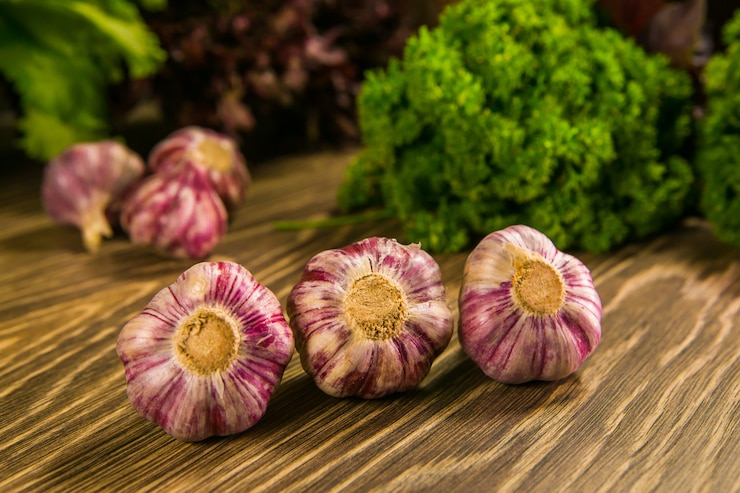Ask Ayurvedic doctor a question and get a consultation online on the problem of your concern in a free or paid mode. More than 2,000 experienced doctors work and wait for your questions on our site and help users to solve their health problems every day.
Shop Now in Our Store
Mountain Garlic Benefits: Science & Health Applications

Mountain garlic—also referred to as “wild garlic,” “bear’s garlic,” “snow mountain garlic,” or “Himalayan garlic”—is hailed in various cultures for its potential health benefits. From traditional remedies to recent scientific discoveries, this potent plant has been credited with properties that may support cardiovascular health, immune function, and more. In this in-depth article, we’ll delve into the science behind mountain garlic’s benefits, its active compounds, practical applications, and considerations for safe use.
Table of Contents
What Is Mountain Garlic?
Mountain garlic is a term commonly used for garlic varieties that thrive in high-altitude or forested regions. In some parts of Europe, the term “mountain garlic” overlaps with Allium ursinum (commonly known as ramsons, wild garlic, or bear’s garlic). In South Asia, particularly in the Himalayan regions, “mountain garlic” may refer to a single clove garlic variant (Allium sativum subspecies) prized for its pungent flavor and believed therapeutic qualities.
Cultural Uses
-
Traditional Medicine: In Ayurvedic and traditional Chinese medicine, mountain garlic has often been used to promote energy, aid digestion, and support immune defenses.
-
Culinary Ingredient: Owing to its intense flavor, it has historically been used to season stews, soups, and pickles, especially in mountainous communities where fresh herbs might be scarce during harsh winters.
Active Compounds in Mountain Garlic
Mountain garlic contains a host of bioactive compounds, many of which are shared with common garlic (Allium sativum), but in higher concentrations or slightly different ratios due to the growing conditions. Key components include:
-
Allicin: A sulfur-containing compound responsible for garlic’s distinctive smell and a bulk of its antimicrobial properties.
-
S-allyl cysteine: Often linked to potential cardiovascular and immune benefits.
-
Alliin: The precursor to allicin, which helps protect the bulb from pests and pathogens.
-
Flavonoids and Polyphenols: Antioxidants that scavenge free radicals and may reduce oxidative stress.
These compounds have been widely studied for their potential health effects, though specific concentrations can vary based on factors such as altitude, soil composition, and processing methods.
Potential Health Benefits
1. Cardiovascular Support
Evidence suggests that certain garlic varieties, including mountain garlic, may help maintain cardiovascular health. A meta-analysis published in the Journal of Nutrition indicated that garlic supplementation can support healthy blood pressure levels and may reduce cholesterol markers in some individuals 11. The sulfur compounds in mountain garlic are believed to help relax blood vessels, thereby potentially aiding in maintaining normal blood pressure.
Key Findings
-
Blood Pressure: A 2008 systematic review in BMC Cardiovascular Disorders concluded that aged garlic extract might help reduce both systolic and diastolic blood pressure 22.
-
Lipid Profile: Some studies show modest improvements in total cholesterol and LDL levels, although the results can vary across different populations.
2. Antimicrobial and Antiviral Properties
Garlic has a storied history as a folk remedy against infections. The allicin in mountain garlic exhibits antimicrobial activity against various bacterial strains, such as E. coli and Staphylococcus aureus, as reported in a paper in Current Opinion in Biotechnology 33. Additionally, preliminary research suggests that garlic may inhibit certain viruses, although more human clinical trials are needed to confirm these effects.
Practical Application
-
Topical Use: Historically, crushed garlic was applied externally to minor wounds, leveraging its antimicrobial qualities. However, prolonged direct contact can irritate skin, so medical consultation is advised.
-
Dietary Consumption: Integrating mountain garlic into meals or taking standardized supplements might help bolster the body’s defense mechanisms, though it should never replace standard medical treatment for infections.
3. Anti-Inflammatory Effects
Inflammation is a natural defense mechanism, but chronic inflammation can contribute to various diseases such as arthritis, heart disease, and metabolic disorders. Some studies posit that compounds in garlic can reduce the production of inflammatory cytokines in the body 44. By potentially modulating inflammatory responses, mountain garlic might serve as a supportive dietary component for overall health.
4. Antioxidant Activity
Oxidative stress occurs when free radicals overwhelm the body’s antioxidant defenses, contributing to cell damage and aging. Polyphenols and flavonoids in mountain garlic are powerful antioxidants that help neutralize these free radicals. According to research published in the Food Chemistry journal, garlic extracts displayed significant free radical scavenging activities 55.
Dietary Tips
-
Pair with Healthy Fats: Some studies suggest that consuming garlic alongside healthy fats (e.g., olive oil, avocado) may enhance the bioavailability of its antioxidants.
-
Gentle Cooking: Light sautéing or mild cooking helps retain many of the beneficial compounds, whereas overheating can degrade allicin and other sulfur compounds.
5. Digestive Aid
In traditional medicine systems, mountain garlic is believed to promote a healthy gut environment. Garlic’s prebiotic properties can support beneficial gut bacteria, aiding in digestion and nutrient absorption 66. For those sensitive to garlic’s pungency, cooked or pickled forms may be gentler on the stomach while still offering some digestive support.
Practical Ways to Incorporate Mountain Garlic
While some individuals consume raw mountain garlic for maximum allicin content, the intense flavor and possible irritation to the digestive tract call for moderate, mindful use. Below are some practical methods:
-
Stir-Fries and Soups: Add sliced or minced mountain garlic to stir-fries, broths, or soups to enhance flavor and nutritional properties.
-
Herbal Infusions: Steep thin slices in warm water or mild broth for a soothing, garlic-infused beverage.
-
Pickling: Pickled mountain garlic is popular in many cultures. This process can reduce the pungency while extending shelf life.
-
Powdered Form: For those who dislike the pungent odor, standardized garlic powders or capsules can be an alternative, although the efficacy may differ from fresh bulbs.
-
Oil Infusions: Infusing high-quality olive oil with chopped mountain garlic can provide a flavorful dressing or marinade; however, take care to store properly to prevent bacterial growth (especially Clostridium botulinum).
Scientific Evidence and Research
Studies on garlic often do not differentiate between flatland garlic, wild garlic, and mountain garlic; however, the overarching body of research on Allium species can offer useful insights. Many clinical trials, meta-analyses, and laboratory studies corroborate garlic’s potential benefits:
-
Blood Pressure: A randomized controlled trial in Maturitas demonstrated that standardized garlic extracts effectively reduced blood pressure in adults with uncontrolled hypertension 77.
-
Antimicrobial Effects: A study in the Journal of Antimicrobial Chemotherapy found that allicin inhibited multiple strains of antibiotic-resistant bacteria 88.
-
Cholesterol Management: A meta-analysis in the Annals of Internal Medicine showed that garlic supplementation can modestly lower total cholesterol levels 99.
While these findings are promising, it’s important to remember that results can be influenced by dosage, preparation method (raw vs. cooked vs. aged extract), and individual health factors.
Possible Side Effects and Precautions
Despite its potential benefits, mountain garlic may pose risks or side effects for certain individuals:
-
Gastrointestinal Discomfort: Consuming large quantities of raw garlic can result in heartburn, gas, or stomach upset.
-
Allergic Reactions: Rarely, people may experience skin rashes or breathing difficulties when exposed to fresh garlic juices.
-
Medication Interactions: Garlic can potentiate the effects of anticoagulants (e.g., warfarin) or antiplatelet drugs, increasing the risk of bleeding. Consult a healthcare provider before introducing garlic supplements if you are on prescription medications.
-
Pregnancy and Lactation: While moderate culinary use is generally considered safe, pregnant or nursing women should seek medical advice before using concentrated garlic supplements.
FAQs on Mountain Garlic
-
What is the difference between mountain garlic and regular garlic?
Mountain garlic typically grows in high-altitude, cooler climates and may contain higher concentrations of certain bioactive compounds. It also tends to have a more pungent aroma and flavor than common garlic varieties. -
How should I store mountain garlic?
Store fresh bulbs in a cool, dry place with good airflow. For long-term storage, you can pickle or dehydrate mountain garlic. Avoid storing garlic-infused oil at room temperature to prevent bacterial contamination. -
Can I use mountain garlic as a substitute for regular garlic in recipes?
Absolutely. However, keep in mind that mountain garlic’s flavor can be more intense, so you may want to reduce the quantity accordingly. -
Does cooking mountain garlic reduce its health benefits?
High heat can diminish allicin, but lightly sautéing or adding it toward the end of cooking can help preserve many beneficial compounds. -
Are supplements as effective as fresh mountain garlic?
Many garlic supplements are standardized for allicin content, which may preserve some benefits. Always look for reputable brands with transparent manufacturing practices and consult your healthcare provider for personalized advice.
Conclusion
Mountain garlic is more than just a robust culinary spice: its blend of sulfur-containing compounds, antioxidants, and antimicrobial properties makes it a compelling subject of scientific exploration. While research continues to uncover its full potential, existing studies suggest that mountain garlic—like other garlic varieties—may support cardiovascular health, bolster the immune system, and offer anti-inflammatory and antioxidant effects.
That said, incorporating mountain garlic into your diet should be part of a broader, balanced lifestyle. Whether you prefer it raw, pickled, or in supplement form, be mindful of potential side effects and interactions with medications. Above all, consult with a qualified healthcare professional before making significant changes to your health regimen.
Call to Action
If you found this article helpful, feel free to share it with friends, comment below with your experiences, or subscribe to our newsletter for more evidence-based health and wellness insights.
Disclaimer and Medical Advice
This article is for informational purposes only and does not replace professional medical advice, diagnosis, or treatment. The potential benefits and effects described may vary from person to person. Always consult a qualified healthcare practitioner before adding a new supplement, especially if you have underlying health conditions, are pregnant, nursing, or taking any medications.
References
11 The Journal of Nutrition (various studies on garlic and cardiovascular health)
22 Ried K, Toben C, Fakler P. Effect of garlic on blood pressure. BMC Cardiovasc Disord. 2008;8:13.
33 Kyung KH. Antimicrobial properties of allium species. Curr Opin Biotechnol. 2012;23(2):142-7.
44 Vargas-Sánchez K, et al. Garlic compounds as an anti-inflammatory agent: A review. BioMed Research International. 2021.
55 Food Chemistry (several studies on garlic’s antioxidant profile)
66 Majewski M. Allium sativum: Facts and myths regarding human health. Rocz Panstw Zakl Hig.2014;65(1):1-8.
77 Ried K, Frank OR, Stocks NP, Fakler P, Sullivan T. Garlic lowers blood pressure in hypertensive individuals. Maturitas. 2010;67(2):144-50.
88 Cutler RR, Wilson P. Antibacterial activity of a new, stable, aqueous extract of allicin against methicillin-resistant Staphylococcus aureus. J Antimicrob Chemother. 2004;53(5):829-831.
99 Stevinson C, Pittler MH, Ernst E. Garlic for treating hypercholesterolemia. Ann Intern Med.2000;133(6):420-429.
By staying informed and practicing moderation, you can harness the potential benefits of mountain garlic while minimizing risks. Let the science guide you as you explore and enjoy this ancient, flavorful, and possibly health-promoting herb.
This article is checked by the current qualified Dr. Harsha Joy and can be considered a reliable source of information for users of the site.



